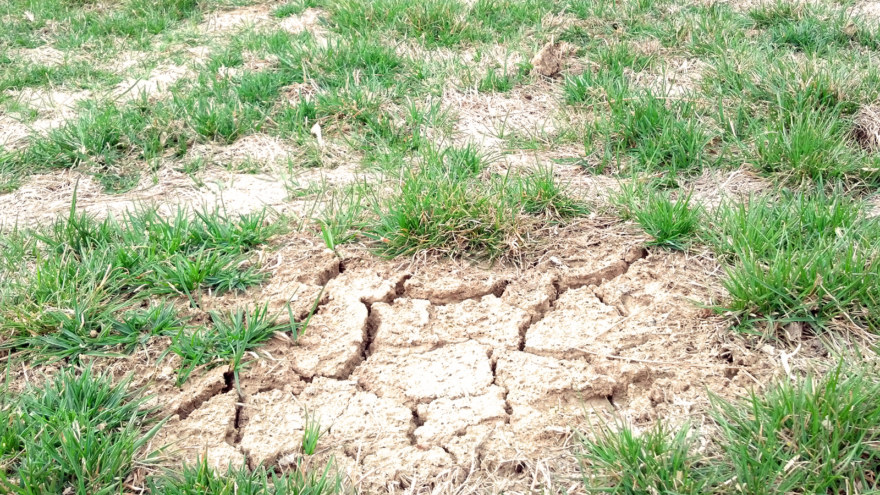Temperature Induced Injury
Temperature Induced Injury
Although ambient temperature is a factor of weather patterns, turf canopy temperature is often a factor of management practices. The detrimental effects of temperature depend on the physiology of the turf at the time of a temperature extreme. Fortunately, environmental fluctuations typically occur gradually and allow for an acclimation or adaptation period which allows turf to survive under extreme temperature fluctuations which allows for less of a chance for temperature induced injury.
High Temperature Injury
 High temperatures induced injury can result in plant metabolic rate imbalances. Under normal ambient temperature ranges, plant enzyme systems increase in activity as temperatures increase; however, once temperatures exceed the optimum for growth, enzyme systems shut down. In addition to reducing growth, temperatures about 104° F can break down these proteins (enzymes), causing further plant injury. While ambient temperatures rarely exceed this threshold, turf canopy temperatures can, especially under drought stress. Drought stressed turf canopies can have temperatures 18°F – 30°F higher than ambient conditions. In hot summer months, canopy temperatures have been shown to be cooler at higher cutting heights. In addition, by maintaining adequate moisture, canopy transpiration (water loss through the leaf blades) will help maintain a cooler canopy.
High temperatures induced injury can result in plant metabolic rate imbalances. Under normal ambient temperature ranges, plant enzyme systems increase in activity as temperatures increase; however, once temperatures exceed the optimum for growth, enzyme systems shut down. In addition to reducing growth, temperatures about 104° F can break down these proteins (enzymes), causing further plant injury. While ambient temperatures rarely exceed this threshold, turf canopy temperatures can, especially under drought stress. Drought stressed turf canopies can have temperatures 18°F – 30°F higher than ambient conditions. In hot summer months, canopy temperatures have been shown to be cooler at higher cutting heights. In addition, by maintaining adequate moisture, canopy transpiration (water loss through the leaf blades) will help maintain a cooler canopy.
High temperature damage can be caused by direct solar radiation, reflected solar radiation from windows or other similar reflective surfaces (increased intensity), objects (containers of hot liquids, metal pails, car floor mats, storm window, etc.) placed on turf in full sunlight and lightning strikes. These heat sources are most detrimental when grasses are not able to cool themselves by evapotranspiration. When turf is covered by an non-permeable material, humidity levels increase and evaporative cooling does not occur. The resulting injury is referred to as scald. Initially turf will appear water soaked, but eventually it will turn brown. This is the same condition resulting from flooding and high temperatures. Cool season grasses are much more susceptible to high temperature injury than warm season grasses.
To avoid damage, select more heat tolerant grasses and consider syringing turf during hot spells to help keep the turf canopy cooler.
Low Temperature Injury
 Under specific conditions, extremely low temperatures can damage turf. Generally, low temperature induced injury results from tissues being mechanically disrupted by internal ice crystals and hydration of the plant crown. This hydration results from the repeated freezing and thawing of the turf. Damage is typically associated with adequate water availability to plant tissue.
Under specific conditions, extremely low temperatures can damage turf. Generally, low temperature induced injury results from tissues being mechanically disrupted by internal ice crystals and hydration of the plant crown. This hydration results from the repeated freezing and thawing of the turf. Damage is typically associated with adequate water availability to plant tissue.
Another form of low temperature injury is winter desiccation. Winter desiccation is the result of drying winds in elevated areas of the landscape. As a protective measure, topdressing and winter blankets can be used on golf greens to avoid low temperature injury. In addition, light watering when air temperatures are above freezing can reduce injury. Selecting grasses adapted to those conditions also would be beneficial.
Frost and Ice Injury
Injury to frosted turf is often associated with traffic from footprints or tire marks, similar to those caused by walking or driving on drought stressed turf. Frozen turfgrass plant tissues become brittle and plant cells are easily damaged by applied pressure.
Symptoms of frost injury are straw brown colored turf. Avoid trafficking frosted turf whenever possible.
 When ice covers turf for long periods, excess moisture combines with freezing conditions to damage turf. This is often associated with soil compaction. Injury resulting from suffocation of turf due to large sheets of ice often will have discoloration patterns which appear as green irregular strips of turf in the damaged area. They result from ice cracking and oxygen being available at the locations. Ice injury often occurs in pockets or depressions where water can accumulate prior to freezing.
When ice covers turf for long periods, excess moisture combines with freezing conditions to damage turf. This is often associated with soil compaction. Injury resulting from suffocation of turf due to large sheets of ice often will have discoloration patterns which appear as green irregular strips of turf in the damaged area. They result from ice cracking and oxygen being available at the locations. Ice injury often occurs in pockets or depressions where water can accumulate prior to freezing.
Reference
L. J. Giesler. (1997). Abiotuc Turf Injury. In F. Baxendale, Ph.D., & R. Gaussoin, Ph.D., Integrated Turfgrass Management for the Northern Great Plains (pp. 168-171). Location: Nebraska

